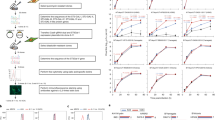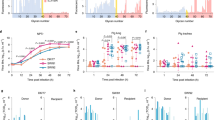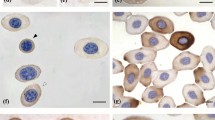Abstract
A temperature sensitive mutant has been isolated for the first time from a replication defective acute leukaemia virus, AEV. In vivo, at 41 °C, the mutant shows a reduced leukaemogenic potential. In vitro, in erythroblasts transformed at 35 °C, haemoglobin synthesis can be induced by a shift to 41 °C. This indicates that the continuous expression of a viral gene product is necessary to maintain the undifferentiated state of the virus-transformed leukaemia cells.
This is a preview of subscription content, access via your institution
Access options
Subscribe to this journal
Receive 51 print issues and online access
$199.00 per year
only $3.90 per issue
Buy this article
- Purchase on Springer Link
- Instant access to full article PDF
Prices may be subject to local taxes which are calculated during checkout
Similar content being viewed by others
References
Graf, T. & Beug, H. BBA Rev. Cancer (in the press).
Graf, T., Fink, D., Beug, H. & Royer-Pokora, B. Cancer Res. 37, 59–63 (1977).
Graf, T. Z. Naturforsch. 30c, 847–849 (1975).
Graf, T., Royer-Pokora, B., Schubert, G. E. & Beug, H. Virology 71, 423–433 (1976).
Graf, T., Beug, H., Royer-Pokora, B. & Meyer-Glauner, W. in Differentiation of Normal and Neoplastic Hematopoietic Cells (eds Clarkson, B., Marks, P. A. & Till, J.) (Cold Spring Harbor Laboratory, New York, 1978).
Royer-Pokora, B. et al. Cell 13, 751–760 (1978).
Stehelin, D. & Graf, T. Cell 13, 745–750 (1978).
Orkin, S. H., Harosi, F. I. & Leder, P. Proc. natn. Acad. Sci. U.S.A. 72, 98–102 (1975).
Hayman, M., Royer-Pokora, B. & Graf, T. Virology (in the press).
Graf, T. Virology 50, 567–578 (1972).
Conscience, J. F., Miller, R. A., Henry, J. & Ruddle, F. H. Expl Cell Res. 105, 401–412 (1977).
Lowry, O. H., Rosebrough, N. J., Farr, A. L. & Randall, R. J. J. biol. Chem. 193, 265–275 (1951).
Crosby, W. H. & Furth, F. Blood 11, 380–383 (1956).
Bruns, G. A. P. & Ingram, V. M. Phil. Trans. R. Soc. B 266, 225–305 (1973).
Bolton, A. E. & Hunter, W. M. Biochem. J. 133, 529–539 (1973).
Kessler, S. W. J. Immun. 115, 1617–1624 (1975).
Kawai, S. & Hanafusa, H. Virology 46, 470–479 (1971).
Friend, C., Scher, W., Holland, J. G. & Sato, T. Proc. natn. Acad. Sci. U.S.A. 68, 378–382 (1971).
Author information
Authors and Affiliations
Rights and permissions
About this article
Cite this article
Graf, T., Ade, N. & Beug, H. Temperature-sensitive mutant of avian erythroblastosis virus suggests a block of differentiation as mechanism of leukaemogenesis. Nature 275, 496–501 (1978). https://doi.org/10.1038/275496a0
Received:
Accepted:
Issue Date:
DOI: https://doi.org/10.1038/275496a0
This article is cited by
-
Retroviral properties inherent to viral erythrocytic infection in sea bass
Archives of Virology (1995)
-
Reflections on the pathogenesis of diseases caused by the acute avian leukosis/sarcoma viruses with special reference to avian erythroblastosis
Veterinary Research Communications (1994)
-
AEV-transformed erythroleukemia cell induced differentiation: Expression of specific cell membrane antigenic molecules
Archives of Virology (1987)
-
Steroid receptors: Oncogenes as hormone receptors
Nature (1986)
-
Abrogation of IL-3 and IL-2 dependence by recombinant murine retroviruses expressing v-myc oncogenes
Nature (1985)
Comments
By submitting a comment you agree to abide by our Terms and Community Guidelines. If you find something abusive or that does not comply with our terms or guidelines please flag it as inappropriate.



